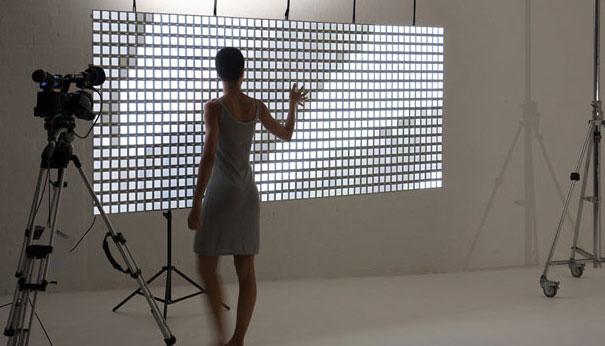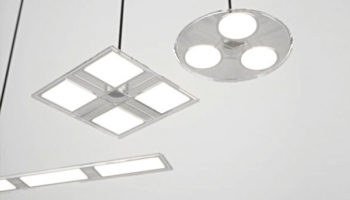rAndom International and Philips Lumiblade Showcase You Fade to Light
From November 30, 2009 until February 7, 2010, a light installation entitled You Fade to Light was shown at the Die Neue Sammlung at the Pinakothek der Moderne in Munich. The interactive wall of light was commissioned by Philips Lumiblade in order to highlight the possibilities of their OLEDs (more on that technology later). Philips hired London-based art and design collective rAndom International, which “was founded in 2002 by Stuart Wood, Flo Ortkrass and Hannes Koch with a vision to create engaging and experimental art and design projects.”
You Fade to Light. Designed by rAndom International and Philips Lumiblade.
The resulting You Fade to Light is a large expanse of flat, mirrored squares made from very thin glass, the Lumiblade OLEDs. If you stand in front of You Fade to Light, your motions and shadows will cause changes in the way the light panel appears: the installation “allows the audience to engage with the light itself intuitively and in a physical way.” You Fade to Light traces your movement, capturing it across the light box. It remains for a moment, a trippy aftershock.
You Fade to Light was built in London “using several hundred OLEDs fromthe world’s first-ever production line for OLED lighting at Aachen, Germany.” With additional software developed by Chris O’Shea, the light piece created by rAndom International came to life. And the installation does highlight the possibilities of Philips Lumiblade OLEDs. Lumiblade is “a glowing sheet that produces a constant light of almost any color.” This means you can cover a wide area evenly, dispersing light in a previously impossible fashion. Less than 2mm thick, the ultraflat surface can be integrated into most design and construction materials. Philips suggests integrating Lumiblade into furniture and interior walls. And the technology should last as long as the design into which it’s incorporated: “Add in a potential lifetime of several 10,000s of hours, an excellent energy efficiency and it's clear why many see Lumiblade as a fit-and-forget solution that's good for the lifetime of an object or interior design.” Did I mention that Lumiblade has built-in diffusers?
By now, you might be extremely frustrated with me, thinking to yourselves, “But what are OLEDs?” They are organic LEDS (light-emitting diodes), which work “by passing electricity through micrometer layers of organic semiconductors sandwiched between two electrodes. The electric current travels from the positive to the negative electrode through the organic film, causing the film to emit light.” Different materials in the film change the color of the light, giving OLEDs a large range of conceivable hues. Lumiblade gets further shine because its OLEDs are fit between two glass plates. Hopefully, that explanation makes more sense to you than it does to me. There is one thing I definitely understand: rAndom International’s You Fade to Light, which should make technophobes like me interested in the OLEDs they don’t comprehend.









Leave a Reply